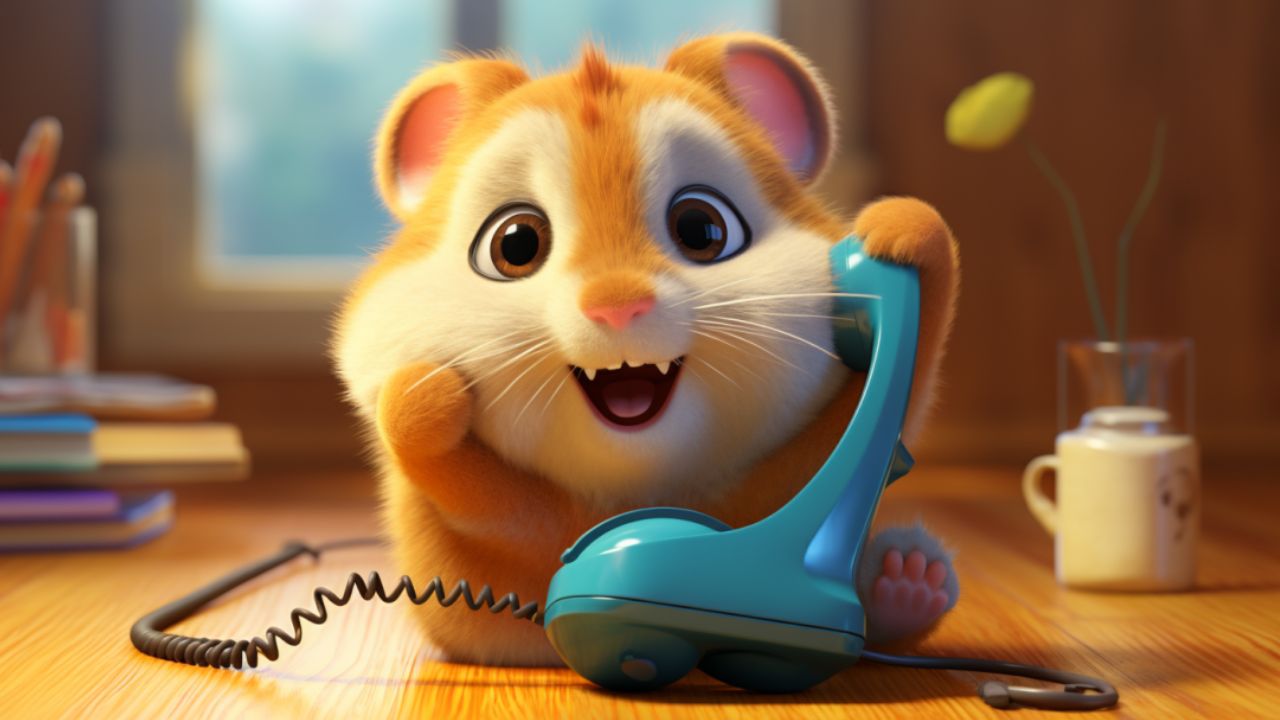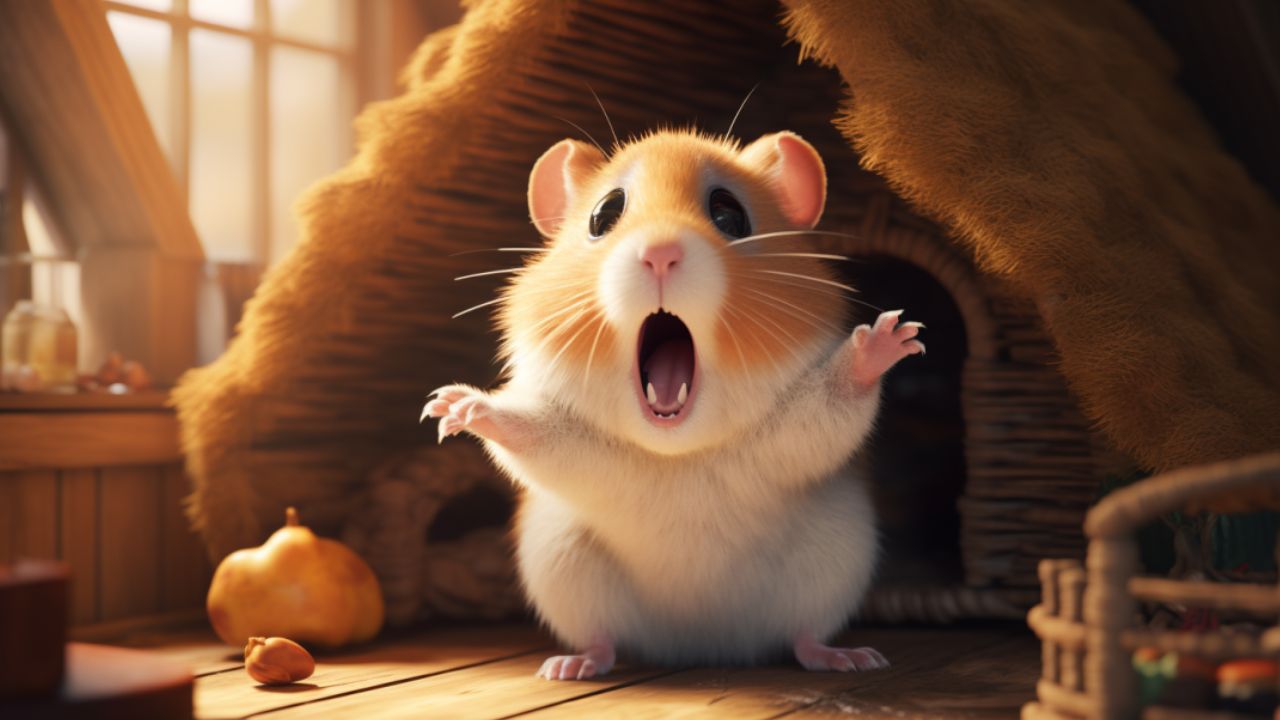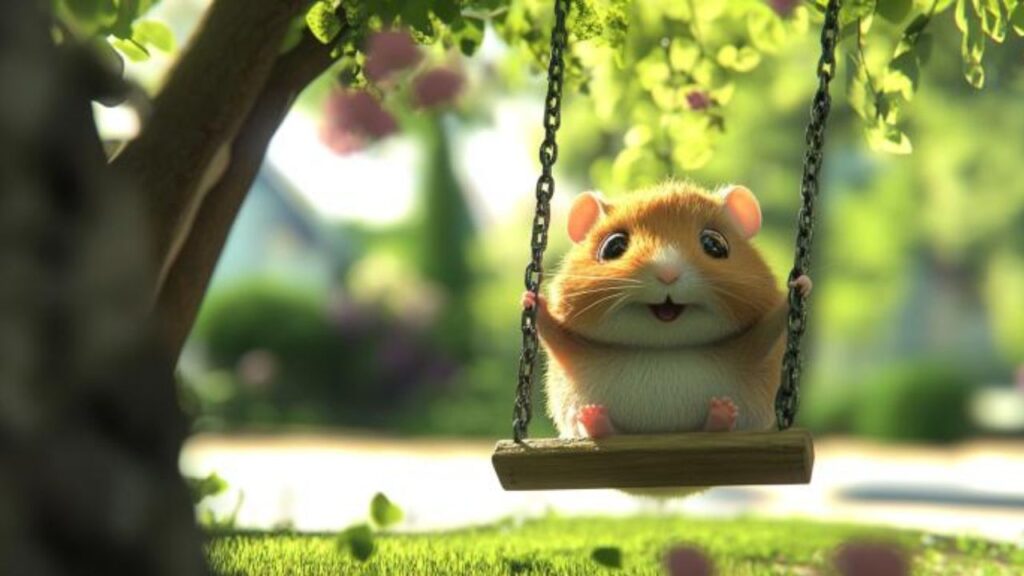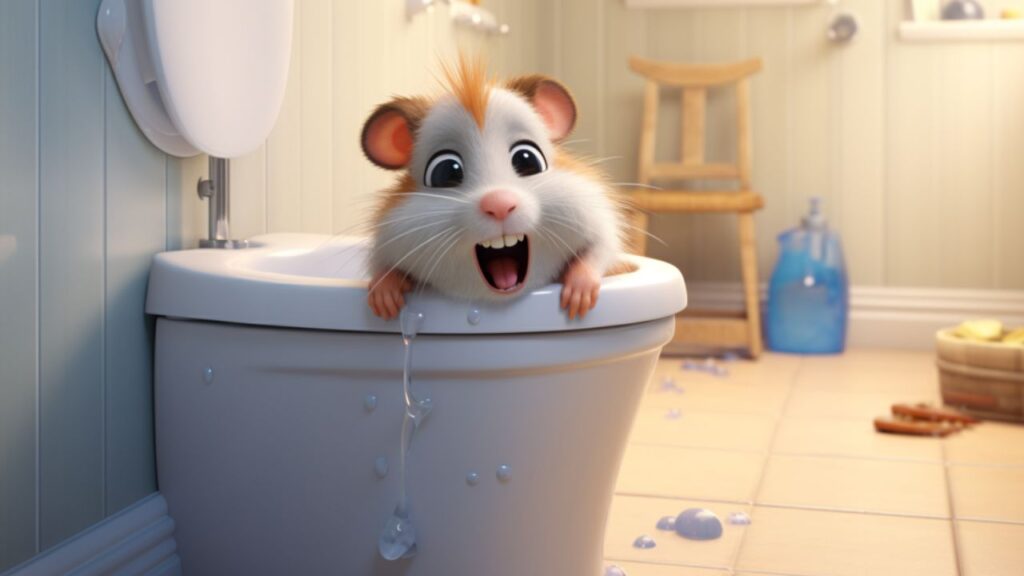🎶🐹 Ready to become the Sherlock Holmes of hamster harmonies? From the high-pitched chirps to the softest of squeals, our furry pals have a lot to say. And guess what? It’s not just random noise! Each sound is a note in the beautiful melody of hamster communication. So, grab your detective hat and magnifying glass, because we’re about to dive into the whimsical world of whisker whispers! 🕵️♂️🔍
A Symphony of Squeaks: Decoding the Hamster’s Language
If one were to lean into the whimsical world of hamsters, they’d be greeted by a symphony of squeaks, chirps, and grunts. And while these sounds might seem arbitrary to the untrained ear, they’re anything but. Every chirp, squeal, and grunt from our furry little friends carries a message. Sometimes it’s a joyous jingle, at other times an anxious alert, and on occasion, it could be a tell-tale sign of discomfort. Just like humans, hamsters have their own intricate language, a blend of sounds and silences that reveal their feelings, needs, and desires.
Setting the Stage for Hamster Harmonies
Before diving headfirst into the depths of hamster dialects, it’s crucial to understand the backdrop. Hamsters, though small, have a rich emotional tapestry. Their environment, their health, their day’s events, and even their interactions with you, all influence the sounds they produce. By decoding these, you aren’t just satisfying your own curiosity; you’re opening a door to deeper communication and bonding with your pet. It’s about breaking down the barriers between species and understanding the subtle cues your hamster throws your way. By the end of this guide, not only will you be more attuned to their vocal nuances, but you’ll also be on the path to becoming what we lovingly refer to as a ‘Hamster Whisperer’.
The Hamster Sound Spectrum: From Chirps to Chatters

As we take this auditory journey, it’s vital to approach it with open ears and an open heart. While some sounds are straightforward, others require a more discerning ear. Some are expressions of pure joy and contentment, while others might be a cry for attention or even a sign of distress. It’s a spectrum, and understanding this range is the first step in truly connecting with your hamster on a deeper level.
The Symphony of Squeaks: A Hamster’s Vocal Concert 🎶🐹
For anyone who’s ever shared their home with a hamster, you’ll agree: these tiny furballs have more to say than you might first think! Every chirp, squeak, and chatter is a note in the melodious symphony that is a hamster’s way of communicating. 🎵 With their expressive little voices, they tell us tales of their moods, desires, and even their health. Let’s embark on a journey to understand and appreciate the various tunes in a hamster’s daily opera.
Hamster Sound Basics: From Chirps to Chatters 🐹🎤
The world of hamster vocalizations is as varied as it is enchanting. They might not be joining an orchestra anytime soon, but their sounds surely are music to our ears:
- Chirps & Tweets 🐦: Often a sign of curiosity or contentment, these are the equivalent of a hamster’s relaxed humming. Maybe they’re exploring a new toy or simply enjoying a lazy stretch.
- Chatters & Clicks 🎵: If your hamster’s teeth are chattering, it could be a sign of excitement, anticipation, or sometimes, a mild annoyance. Think of it as their way of saying, “Hey, I noticed that!”
- Squeals & Screams 😱: These high-pitched sounds might indicate distress, fear, or discomfort. It’s essential to check on them immediately if you hear this, as they might be in pain or feeling threatened.
- Purring Sounds 😊: Yes, hamsters can purr! Not exactly like cats, but this soft, continuous sound is a clear indication of a happy and content hamster.
Tuning in to Tiny Tones 🎧🐹
To the untrained ear, a hamster’s sound might just seem like random background noise. But with a bit of attention and observation, you can begin to distinguish the unique notes in your hamster’s daily serenade. Every sound, whether soft or loud, holds a story, a clue to your pet’s current state of mind.
Understanding these sounds is more than just a fun exercise; it’s a window into your hamster’s world. Knowing when they’re happy, anxious, curious, or even unwell allows you to cater to their needs effectively. This auditory bond strengthens the connection between you and your furry companion, ensuring their emotional and physical well-being is always in tune. So, next time your hamster chirps, chatters, or purrs, lean in and listen. They’re sharing a song from their heart, and it’s one worth tuning into! 🎶🎵🐹🎧
The Science Behind the Sounds: Diving Deep into Hamster Harmonics 🧪🐹🔊

While we might adore the cute symphonies our little pals produce, there’s an intricate web of science and evolution behind each chirp and chatter. By grasping the neurological and evolutionary roots of these sounds, we can better appreciate and understand our furry friends.
The Brainy Side of Hamster Hubbub: A Neurological Notesheet 🧠🎼
When your hamster chirps, squeals, or purrs, it’s not just a random act. It’s their brain hard at work! Neuroscience has revealed fascinating insights into how hamsters communicate:
- Emotion Centers Light Up: Just like humans, hamsters have areas in their brain responsible for emotions. When they vocalize, specific regions linked to joy, anxiety, or excitement get activated. So, a joyful chirp might come from the hamster’s equivalent of our brain’s happiness center!
- Frequency Matters: Different emotions are often tied to varying sound frequencies. High-pitched sounds, like squeals, may be linked to distress or alarm, while lower frequencies, like purring, might indicate contentment. The hamster brain is wired to produce and interpret these nuances in vocal tone.
- Memory and Sounds: Hamsters can remember and recognize specific sounds, especially if they’re linked to certain events or emotions. Over time, a specific vocalization can become a learned response to a particular stimulus or situation.
Evolutionary Echoes: The Melodies of Mother Nature 🍃🎵🐹
Why did hamsters evolve to have such a wide range of vocalizations? The answers lie in their wild ancestors and the environment they inhabited:
- Survival in the Wild: In the vast expanses of the wild, being vocal helped hamsters communicate with family members, warn of potential dangers, or even attract mates. A robust vocal range ensured that they could convey different messages effectively.
- Social Structure: Hamsters are social creatures. Historically, they lived in groups, and a rich tapestry of sounds enabled them to establish hierarchies, bond with group members, and even mediate conflicts.
- Environmental Adaptations: The diverse habitats of ancient hamsters—from deserts to meadows—influenced their vocal behaviors. For instance, a hamster in a predator-dense area might develop more discreet, low-frequency sounds to avoid attracting unwanted attention.
Understanding the science and evolution behind hamster sounds not only enriches our appreciation for these wonderful creatures but also underscores the depth of their intelligence and adaptability. So, the next time you hear a hamster serenade, remember: there’s a world of history and biology in every note! 🌍🎶🐹🔬
Common Hamster Calls and Their Meanings 🐹🔊

Our tiny furballs, while pint-sized, come with an orchestra of sounds that they use to communicate. It’s a lively melody of hums, chirps, squeals, and more. By tuning into this hamster radio, you can not only understand their moods but also tend to their needs more effectively.
Happy Hums and Chirps: The Melodies of a Merry Hamster 🎵🐹💖
These are the sounds every hamster parent loves to hear. When your hamster is humming, chirping, or even purring, it’s a sign that they’re in a good mood:
- Chirps and Twittering: Often heard when your hamster is exploring new territories or enjoying some playtime. It’s their way of saying, “I’m curious and having fun!”
- Soft Purring: Yes, hamsters can purr too! It’s not just a cat thing. If your hamster emits a soft purring sound when you’re holding or petting them, it’s a sign of pure contentment.
- Humming: This gentle hum is a hamster’s way of showing interest, especially when they encounter a new toy or treat. It’s like their version of a happy hum.
The Squeals and Squeaks of Distress: Urgent Hamster Alerts 🚨🐹
These are sounds you should be vigilant about. Squeals and loud squeaks often signal that your hamster is feeling threatened, scared, or in pain:
- Sharp Squeals: A reaction to sudden disturbances, like an unexpected loud noise or if they feel trapped. It’s their way of shouting, “I’m scared!”
- Frantic Squeaking: If two hamsters are squeaking loudly at each other, it might be an indication of a disagreement or territory dispute.
- Prolonged Squeals: These can be signs of physical discomfort or pain, especially if you notice them when the hamster is moving or trying to access a particular area of their cage.
The In-Between Noises: Decoding the Hamster Enigmas 🤔🔍🐹
And then there are those sounds that leave us scratching our heads:
- Chattering Teeth: This could be a sign of annoyance or a mild threat. It’s your hamster’s way of saying, “Back off a bit!” It might also indicate that they’re feeling a tad cold.
- Hissing: Yes, hamsters can hiss, though it’s rarer. This is usually a defensive sound, suggesting they’re feeling threatened or protective of their territory.
- Whining or Whimpering: These softer sounds can be indicative of mild distress or uncertainty. Maybe a new toy is puzzling them, or they’re unsure about a new treat you introduced.
By getting attuned to these distinct hamster calls, you’re taking a big leap towards understanding and caring for your pet on a whole new level. Every chirp, squeal, or chatter is a window into their world, waiting for you to peek in and join the fun! 🎶🌍🐹🎉
Responding to Your Hamster’s Communications 🐹🗨️

Engaging with our hamster pals is more than just offering them treats or toys. It’s about understanding their unique language and responding in ways that nurture the bond. Let’s delve into how you can be the perfect conversational partner to your furry friend.
Creating Comfort: Lending a Listening Ear 🐹👂🛏️
Hamsters may not speak our language, but they sure have their ways of telling us when they’re uncomfortable:
- Addressing Distress Signals: If you hear loud squeaks or see frantic movements, it’s vital to check on their well-being immediately. Is there something in the cage bothering them? Are they entangled or stuck? Quick checks can prevent bigger issues.
- Cage Comfort: A hamster’s cage is its kingdom. Ensure it has soft bedding, hiding spots, and plenty of space to move around. A happy hamster home means fewer distress calls!
- Temperature Tunes: If your hamster is chattering its teeth, it might be feeling cold. Maintain an optimal temperature, avoiding sudden fluctuations.
Interactive Interactions: Echoing the Emotions 🐹🎤❤️
Building trust is a two-way street. It’s not just about understanding your hamster’s sounds but also about how you respond:
- Mirroring their Mood: If your hamster is chirpy and playful, use soft, gentle tones to communicate back. It creates an atmosphere of mutual joy and playfulness.
- Comforting Cooing: In times of distress, use soothing tones to calm them down. Gentle strokes paired with comforting words can work wonders.
- Building Trust with Tones: Regularly talk to your hamster. Over time, they’ll start recognizing your voice and associate it with safety and care.
- Sound Play: Experiment with mimicking some of their happy sounds. You’d be surprised how intrigued and engaged they become, further strengthening your bond.
Remember, your hamster is not just a pet; they’re a companion. Engaging with them through sounds and responses creates an enriching environment, fostering trust, and building an unbreakable bond. 🎶🐹❤️🤗
Hannah’s Training Tactics 🐹🎤📘

Welcome to my favorite section, dear hamster enthusiasts! Here, I spill the beans on some of my go-to tactics for bonding and training. Let’s tune into our little furballs and take our relationship to the next level. 🎶🎧🐹
Hammie Listening 101: Attuning to the Tiny Tunes 🎵👂
Understanding your hamster is the first step in training. Here’s how to be a master listener:
- Quiet Time: Dedicate a few minutes daily to just listen. Get down to their level, sit still, and pay attention to the different sounds they make.
- Note Down: Maintain a “Hammie Diary.” Jot down the sounds you hear and the context they appear in. Over time, you’ll see patterns emerge.
- Audio References: There are online resources with audio clips of various hamster sounds. Compare them with what you hear to better understand your pet.
Sound Play: The Musical Bond 🐹🎼
Engaging with your hamster isn’t only about understanding them—it’s about communicating back:
- Echoing Emotions: If your hamster chirps happily, mimic the sound gently. It’s a fun way to interact and might just get you a curious look or two.
- Sound Toys: Introduce toys that produce soft sounds. Watch how your hamster reacts. It’s an engaging way to stimulate their senses.
- Talk to Them: Just as they have their language, introduce them to yours. Talk gently, and soon, they’ll associate your voice with comfort.
Troubleshooting Tips: Soothing the Squeaks 🐹❤️🔧
Every relationship has its hiccups. Here’s how to address and soothe your hamster when they’re frequently distressed:
- Regular Checkups: If the distress calls are frequent, ensure there’s no health issue. A trip to the vet might be in order.
- Safe Spaces: Provide more hiding spots in their cage. Sometimes, they just need a little alone time.
- Distract and Divert: Introduce a new toy or treat when they’re agitated. The novelty can sometimes distract them from whatever is causing distress.
And as always, patience is key! With these tactics and some time, you’ll not only understand your hamster’s vocalizations but also foster a deep, trusting bond. 🐹🎤🌟
Finishing Touches: Whispered Wisdom 🐹🍃🔍

As we draw the curtain on this whirlwind journey through hamster vocalizations, let’s take a moment to reflect on what this newfound knowledge means for your bond with your furry companion.
Harnessing the Power of Listening: Beyond the Squeaks and Chirps 🎵❤️
When we begin to understand the sounds our hamsters make, we do more than just translate their language. By tuning in to their squeaks and hums, we show them that we care, value their feelings, and are genuinely invested in their well-being. Over time, this deepens trust, establishes respect, and fosters a bond that’s truly special. More than training, it’s about building a relationship built on mutual understanding and love. And guess what? Your hamster notices. That added bounce in their step, that chirp of pure contentment—it’s their way of thanking you.
A World Beyond Words: The Unspoken Bond 🐹💞
While vocalizations are a critical part of understanding your hamster, remember that much of your bond lies in the silent moments. The way your hamster snuggles into your hand, those calm moments when they rest against you, or even the cheeky way they might tug at your sleeve—it’s all part of a rich tapestry of communication. These silent interactions, combined with your understanding of their vocal cues, create a connection that’s beyond words, rooted in genuine emotion.
With paws and patience, you’re on the road to being a Hamster Whisperer. Happy training! 🌟🐹🎉




